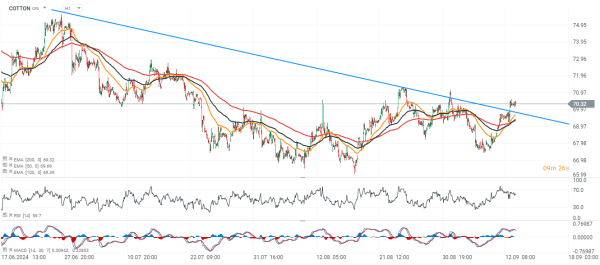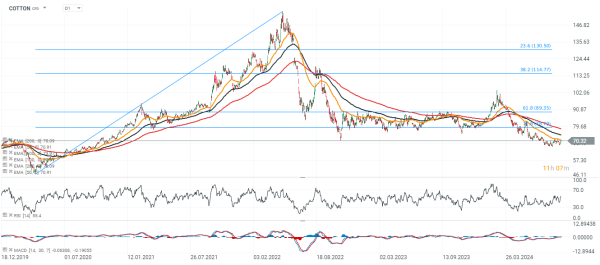Cotton jumps above $70 amid USDA WASDE report and Francine hurricane worries crops in Missisipi📈
Cotton futures, on the ICE exchange (COTTON) have risen above $70 and from multi-year lows are currently gaining 5%. The gains were spurred by lower production estimates from yesterday's USDA WASDE report and concerns about the Mississippi Delta crops, which could disrupt supply in the US market. Agricultural forecasters expect cotton yields per acre this year to be the lowest since 2015. The U.S. cotton balance sheet for the 2024/25 season shows a decline in production, exports and ending stocks compared to last month, with domestic demand forecast flat.
- Smaller harvests in the United States, India and Pakistan more than offset larger harvests in China. In the report, global production was reduced by about 1.2 million bales, down by about 460,000 bales, mainly due to a drop of 200,000 bales in Vietnam and 100,000 bales in Bangladesh and Turkey.
- Global ending stocks declined by 1.1 million bales from August to about 76.5 million today. The Agriculture Department indicated that the drought in Arizona, Oklahoma and Texas is putting a strain on crops. Crop adjustments in these US regions are offsetting (still) fairly good harvests in Louisiana, California and New Mexico.
Will Francine support the momentum in cotton prices?
The market may begin to worry that already drought-laden yields could fall again, depending on the damage of Hurricane Francine. This one threatens crops in the Mississippi Delta, a region that has so far still had a good harvest.
- Through still weaker demand from major textile producers China, Vietnam, Turkey and Bangladesh, among others, cotton is still trading near multi-year lows, and seasonal factors are still a fraction of the broader fundamental background
- A USDA report indicates that U.S. farmers will harvest about 807 pounds of cotton per acre this year (down 10% y/y). Although crop yields have declined, final yields will nevertheless be higher than in 2024 due to 1 million more acres planted and fewer acres written off by farmers. Nonetheless, they were lowered by 33 pounds from the August estimate
- In addition, the recent rebound in oil prices after big declines has supported cotton, and any further increases could potentially raise polyester supply chain costs. Currently, key harvest regions continue to experience unfavorable weather conditions for the crop. Cotton futures are up for the third consecutive session, and the decline in the dollar has supported agricultural commodities. Currently, the increases are still somewhat limited, as WASDE also slightly lowered consumption estimates.
The latest Commitment of Traders (CoT) report indicated that producers are beginning to hesitate to hedge supply. A group of Managed Money (funds and large speculators) has withdrawn more than 4,400 contracts in short positions, and while these still far outweigh long positions, there is potential to cover positions, as there is in wheat.
COTTON charts (H1, D1)
Cotton futures contracts have broken above the short-term downtrend line and are testing the area above $70.
Source: xStation5
Cotton is approaching the 50-session exponential moving average on the daily interval (EMA50, orange line), at $71.
Source: xStation5